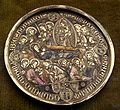Vitreous enamel
| Advanced search |
- About 13 results found and you can help!
 Cloisonné enamel plaque, Byzantine Empire, ca. 1100 |
Vitreous enamel, also porcelain enamel in U.S. English, is a material made by fusing powdered glass to a substrate by firing, usually between . The powder melts, flows, and then hardens to a smooth, durable vitreous coating on metal, and also glass or ceramics, although the use of the term "enamel" is often restricted to work on metal, which is all that this article covers; enameled glass is also called "painted". The fired enameled ware is a fully laminated composite of glass and metal. The word enamel comes from the High German word smelzan (to smelt) via the Old French esmail. Used as a noun, "an enamel" is a usually small decorative object, coated with enamel coating. Enameling is an old and widely-adopted technology, for most of its history mainly used in jewelry and decorative art, but since the 19th century applied also to industrial materials and everyday consumer objects, especially cooking vessels. "Enamelled" and "enamelling" are the preferred spellings in British English, while "enameled" and "enameling" are preferred in American English.
- Related: Ceramic glaze, Nineveh, Rostov the Great, Staffordshire Moorlands Pan, Franz Ullrich, Fred Uhl Ball, Vitreous china
| Pokany - Cloisonné Enamel Pokany - Cloisonné Enamel www.pokany.com - Web |
| Enamels on jewelry Enamels on jewelry www.langantiques.com/.../Enamels_on_jewelry#Email_brun - Web |
| Mechanical and Physical Properties of Vitreous Ena... Mechanical and Physical Properties of Vitreous Enamel www.porcelainenamel.com/pei502.htm - Web |
Gallery for «Vitreous enamel»
- Enamel 2.jpg
Average relevance
| VEA Vitreous Enamel Association (UK) VEA Vitreous Enamel Association (UK) www.vea.org.uk - Web |
| Glass on Metal Magazine Online (US) Glass on Metal Magazine Online (US) www.glass-on-metal.com - Web |
| CIDAE Center of Information and Diffusion of the A... CIDAE Center of Information and Diffusion of the Art of Enamelling (ES) www.cidae.com/cidae_ing.htm - Web |
| Society of Dutch Enamellers (NL) Society of Dutch Enamellers (NL) www.enamellers.nl/index.php?l=uk - Web |
| The Enamelist Society (US) The Enamelist Society (US) www.enamelistsociety.org - Web |
| Guild of Enamellers, UK Guild of Enamellers, UK www.guildofenamellers.org - Web |
| Porcelain Enamel Institute (US) Porcelain Enamel Institute (US) www.porcelainenamel.com - Web |
| International Enamellers Institute International Enamellers Institute www.iei-world.org - Web |
Low relevance
| (INDIA) (INDIA) www.vasudevenamel.com - Web |
| Enameller Darba Spars Ltd. (LV) Enameller Darba Spars Ltd. (LV) www.darbaspars.lv/.../product_detail.php?l=en&id_group=8&id_subgroup=0&id_product=14&page=1&position=0 - Web |



